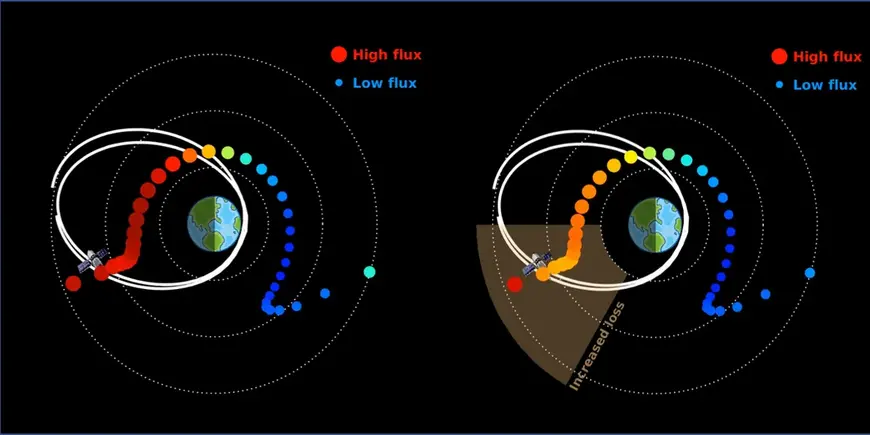Home » News
New findings on the electron ring current enhancement
In the resent study, Bernhard Haas and co-authors found that the enhancement of the electron ring current during the geomagnetic storms is challenging to reproduce in the modeling, and it is attributed to a new missing scattering processes.
Charged particles from space are captured by the Earth’s magnetic field. They then flow in a circular path around the Earth, forming what is known as a ring current. Knowledge of its dynamics is important because it in turn affects the Earth’s magnetic field and atmosphere and can create dangerous conditions for satellites. In particular, the behaviour during geomagnetic storms caused by increased solar activity is not yet fully understood. Models used for this purpose have so far systematically overestimated the strength of the ring current. Researchers led by Bernhard Haas and Yuri Shprits from the GFZ German Research Centre for Geosciences have shown this in a study published in the journal Nature Scientific Reports. They analysed the particle trajectories during geomagnetic storms and identified a hitherto unrecognised particle loss process through scattering by so-called plasma waves.
See full article at GFZ website.
Electrons approach the speed of light when plasma density is low
In a recent study, Allison et al. found that depletions in plasma allowed electrons to accelerate to ultra-relativistic energies. The study used data from the Van Allen Probes as well as machine learning techniques to make these findings, which were published in Space Advances.
“This study shows that electrons in the Earth’s radiation belt can be promptly accelerated locally to ultra-relativistic energies, if the conditions of the plasma environment — plasma waves and temporarily low plasma density — are right. The particles can be regarded as surfing on plasma waves. In regions of extremely low plasma density they can just take a lot of energy from plasma waves. Similar mechanisms may be at work in the magnetospheres of the outer planets such as Jupiter or Saturn and in other astrophysical objects,” — Yuri Shprits
Check out press coverage in Science Daily and on the GFZ website and read the full paper here.
PAGER project started
EU Horizon 2020 project PAGER started. The kick-off meeting held in Potsdam at GFZ.
We’re excited to get our EU Horizon2020 project PAGER started! Kick-off meeting @GFZ_Potsdam pic.twitter.com/GNujSchUmT
— spacepager (@spacepager) January 28, 2020
The PAGER project will combine models from the Sun to the Earth’s inner magnetosphere + ensembles of physics-based & ML models to make predictions of space weather conditions 1-2 days in advance
Strong whistler mode waves observed in the vicinity of Jupiter’s moons
In the vicinity of Europa and Ganymede, that respectively have induced and internal magnetic fields, chorus wave power is significantly increased. The observed enhancements are persistent and exceed median values of wave activity by up to 6 orders of magnitude for Ganymede. Produced waves may have a pronounced effect on the acceleration and loss of particles in the Jovian magnetosphere and other astrophysical objects. The generated waves are capable of significantly modifying the energetic particle environment, accelerating particles to very high energies, or producing depletions in phase space density. Observations of Jupiter’s magnetosphere provide a unique opportunity to observe how objects with an internal magnetic field can interact with particles trapped in magnetic fields of larger scale objects.
Part-time Job for CS undergraduates in Space Environment Modeling Group
Update: The hiring process is finished.
Space Environment Modeling Group (https://rbm.epss.ucla.edu/) in the UCLA Department of Earth, Planetary, and Space Sciences is looking for part-time undergraduate student with strong CS background to join our team. It’s a good chance for you to be involved in cutting-edge research, to sharpen your CS skills, and to work with like-minded individuals. You will be paid for your work, and compensation will depend on your experience
Multi-MeV Electron Loss in the Heart of the Radiation Belts
The profiles of phase space density (PSD) showed clear deepening minimums consistent with the scattering by electromagnetic ion cyclotron (EMIC) waves . Long-term evolution shows that local minimums in PSD can persist for relatively long times. (more…)
Dependence of radiation belt simulations to assumed radial diffusion rates
Radial diffusion is one of the dominant physical mechanisms that drives acceleration and loss of the radiation belt electrons, which makes it very important for nowcasting and forecasting space weather models. Comparison of the simulation results with observations showed that the difference between simulations with different radial diffusion parameterization is smaller than the inclusion of local acceleration and pitch angle diffusion. (more…)
Numerical applications of the advective-diffusive codes for the inner magnetosphere
Accuracy of space weather prediction depends strongly on the quality of the models. A team led by the GFZ German Research Centre for Geosciences demonstrates how errors in the algorithms can lead to wrong predictions. (more…)
Wave-induced loss of ultra-relativistic electrons in the Van Allen radiation belts
A geomagnetic storm on January 17, 2013, provided unique observations that finally resolved a long-standing scientific problem. (more…)
Dr. Tatiana Podladchikova Awarded International Alexander Chizhevsky Medal
Applied Mathematician Dr. Tatiana Podladchikova was awarded the International Alexander Chizhevsky Medal at the 12th European Space Weather Week, for major results in space weather.





